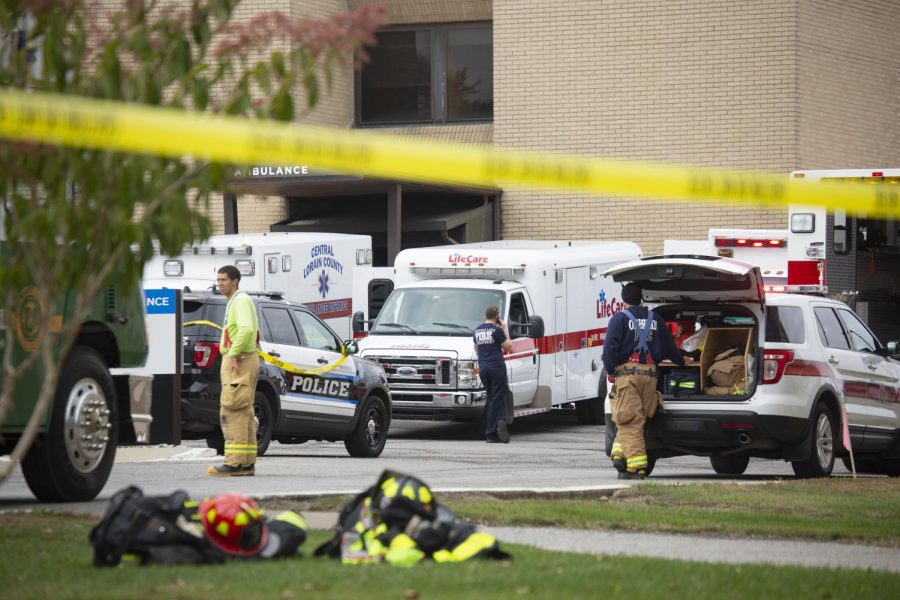Unknown Substance Causes Emergency at Walmart, Mercy ER
Emergency responders stand outside of Mercy Allen Hospital on Tuesday after seven people were exposed to an unknown substance.
An unknown substance originating in the Oberlin Walmart parking lot left seven people sick or unresponsive on Tuesday. Some of the exposures occurred in Mercy Allen Hospital and resulted in the hospital employing its emergency management plan and temporarily evacuating its emergency room.
Chemical testing is still ongoing, but Chief of Police Ryan Warfield says he suspects the substance was fentanyl. The exposures began when police responded to a call reporting a suspicious individual walking in and out of Walmart and potentially stealing from the store.
“Officers went to Walmart to check the situation out and talk to the subject,” Warfield said. “One of the officers made contact with the subject and she started to feel sick — she felt ill from what is suspected to be fentanyl. She Narcaned herself and after a brief moment, the subject got sick as well. An ambulance was called for the subject and the officer.”
According to President of Mercy Health Allen Hospital Charlotte Wray, the hospital was already in the process of preparing for the situation by the time the ambulance arrived.
“When the first two victims were on route to the hospital, [the staff] believed they knew what they were dealing with,” Wray said. “We have protocols that include gowning and gloving and putting on face masks and goggles — because they know you don’t want to get exposed to that stuff. So they received the suspect and the police officer and quickly began treatment. And shortly after arrival, the EMT [assisting in the ambulance] started exhibiting some symptoms, so at that point, we were treating three folks. And it just kind of accelerated from there.”
According to Wray, several nurses and healthcare workers also became sick once the patients were admitted to the hospital.
“There were seven people that were exhibiting symptoms and six [of them] received treatment — including the initial suspect and the police officer,” Wray said. “I’m not at liberty to get into the specifics of the clinical situation, but the people exposed to the substance may be feeling extremely weak, dizzy, or confused. They may lose consciousness and stop breathing. It is very serious.”
As a precaution, emergency workers blocked off a section of West Lorain Street for several hours, according to Supervisor of Campus Safety Tyrone Wilks.
“We were asked by the fire department to assist with traffic control and making sure people stayed out of the area,” Wilks said. “We’re always happy to participate in stuff like that because our main goal is to make sure all of our staff, students, and faculty are safe. … During that time our department was actively engaged in making sure the alerts were going out to the College staff, students, and people from the emergency contact list.”
In addition to cordoning off the street, Mercy Allen Hospital called upon the surrounding facilities and ambulance crews to mitigate risks.
“If one hospital is in crisis, you can divert ambulances for short periods of time to another hospital,” Wray said. “It doesn’t happen very often, but in situations like this, that’s what you do. We also were transferring patients that were in the emergency room out, because we didn’t want to expose anybody to what was going on — because at that time you’re not always certain what you’re dealing with. In spite of planning and preparing for everything, you just never know.”
The origin of the substance, as well as its effects, are still being investigated.
“We think it’s likely the substance was fentanyl, however at this time the lab results came back negative,” Warfield said. “But there’s still other stuff they are testing and the report has not been released yet.”
Reports of incidences of emergency responders becoming ill or even unresponsive due to exposure from fentanyl — a drug that is sometimes 100 times more potent than morphine, according to the Centers for Disease Control and Prevention — have been prevalent since at least 2016.
“In the media, we’ve seen examples where first responders, family members, and people that are struggling with addiction come in contact with this substance and it completely incapacitates them,” Wray said. “There [are] definitely precedents around how you develop a plan way ahead of time. You know, the threat of exposures are part of the scary reality that we live in.”
However, many in the scientific community believe there is little evidence that shows that these experiences across the country are a result of contact with a drug.
A 2017 statement published by the American College of Medical Toxicology says that “it is very unlikely that small, unintentional skin exposures to tablets or powder would cause significant opioid toxicity, and if toxicity were to occur it would not develop rapidly, allowing time for removal.”
Some medical professionals likewise harbor doubts about the feasibility of these incidents.
“I would say it’s extraordinarily improbable that a first responder would be poisoned by an ultra-potent opioid,” Dr. David Juurlink, a clinical researcher at Sunnybrook Health Sciences Centre in Toronto said in a New York Times article (“What Can Make a 911 Call a Felony? Fentanyl at the Scene,” Dec. 17, 2018). “I don’t say it can’t happen. But for it to happen would require extraordinary circumstances, and those extraordinary circumstances would be very hard to achieve.”
However, stories of emergency responders who experience such reactions after touch exposure to fentanyl and other drugs are very common, and more research needs to be done to determine if these are a result of the drug or if there is a psychological reason. Some suggest a “nocebo effect,” meaning that symptoms like shortness of breath, nausea, and passing out are still very real, but stem from expectations of danger, rather than chemicals.
In any case, Wray stresses the importance of being aware of any potential dangers.
“Exposure to drugs and substances is something that should be a safety concern for everybody,” Wray said. “I think most importantly if anybody has a loved one or friend that has an addiction, they really need to practice additional caution. What you’ve read in the papers [and] seen on the news is [that] these drugs and substances are getting very, very strong and they’re incredibly deadly. So we need people to take additional caution and we need them to seek treatments. We need them to get help.”







